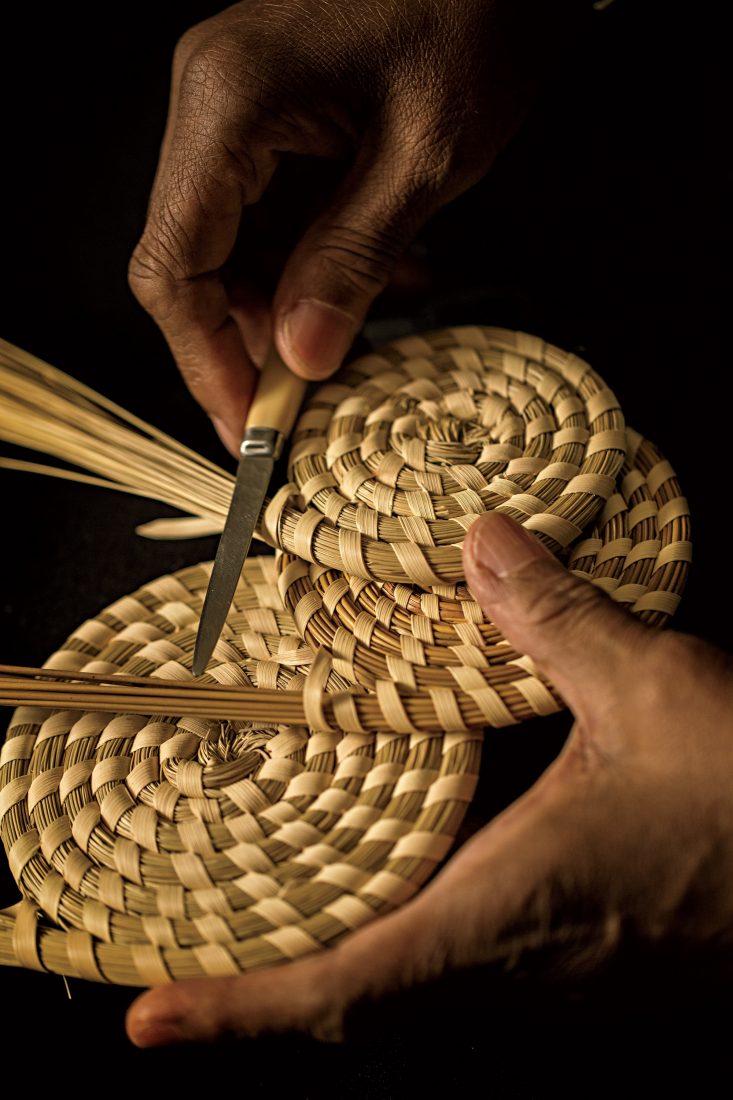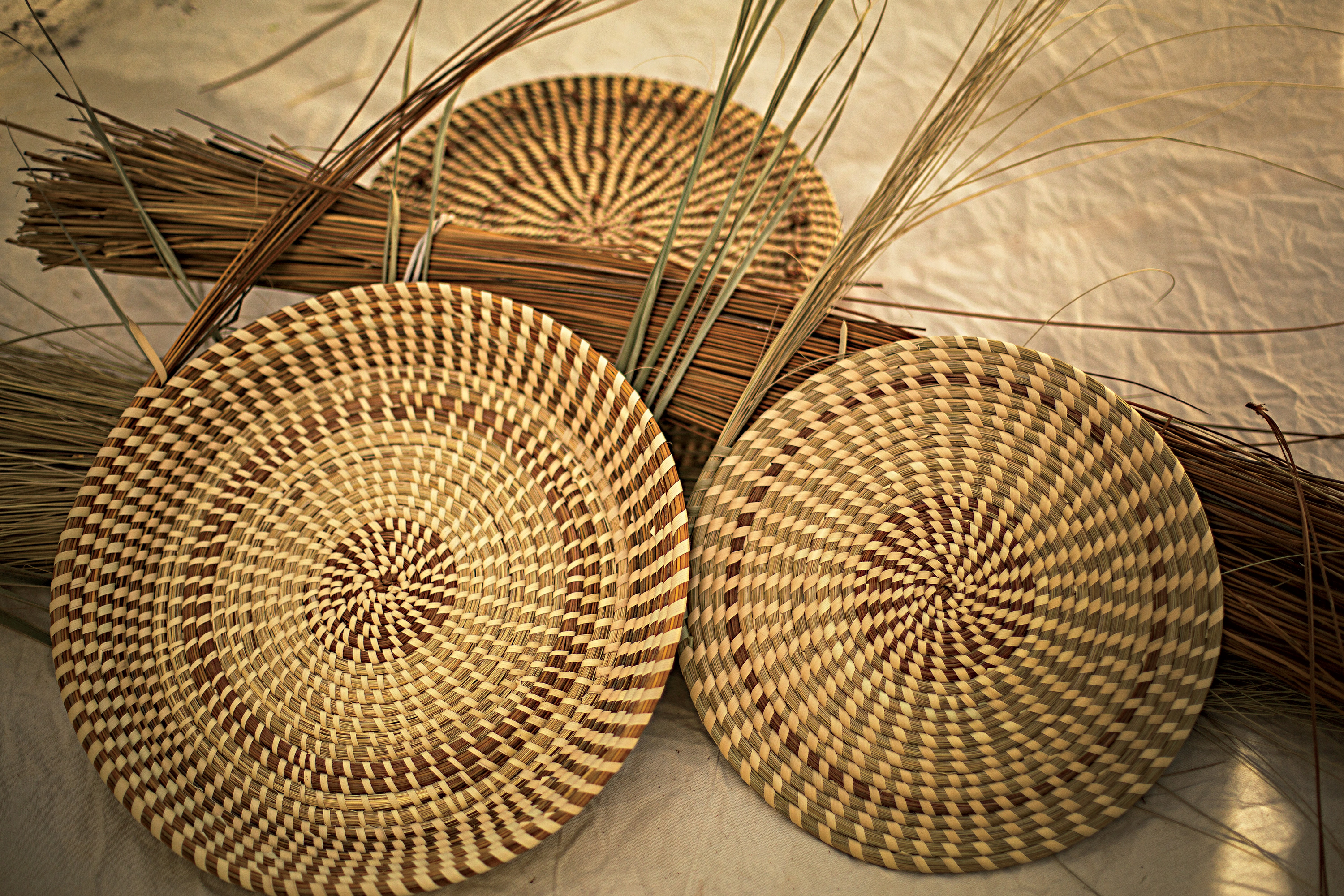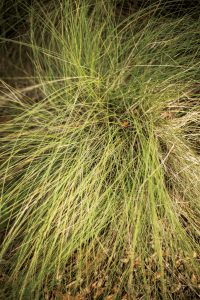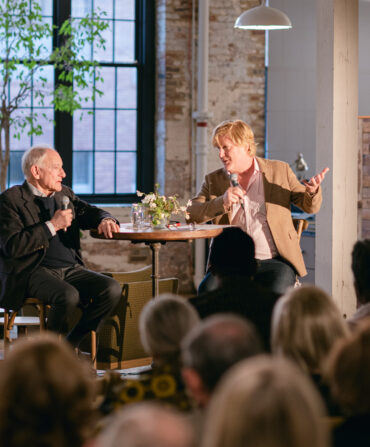Southern Masters
A Lowcountry Legend: Mary Jackson
With a devotion to perfection and a penchant for innovation, Mary Jackson has taken the age-old art of sweetgrass basket weaving to the world stage

Photo: Erika Larsen
Rows of coiled sweetgrass baskets stretch out across the tables in Charleston, South Carolina’s historic City Market, basket weaver beside basket weaver, fingers ticking away over sweetgrass and palmetto. So it has been for decades, today’s weavers only the latest practitioners of this Gullah tradition, one of the oldest surviving African art forms in the United States. The arrival of any one new basket weaver at the Market is not, in itself, cause for particular note. Yet when Mary Jackson first displayed her baskets here one Saturday in 1980, she says, “people stopped in their tracks.”
Looking at photos in her small Charleston studio recently, Jackson finds a picture of one of the baskets she first displayed that day. “It’s not far away from a traditional idea,” she says, “and it’s using the same traditional materials…” But the basket—a shallow bowl with a high sweeping handle—was unlike anything seen before. At once timeless and contemporary, it seems to have been built upon perfect circular molds, the handle incredibly thin and graceful, the sweetgrass coils exceptionally precise, loops of palmetto ribbons fanning out across them in almost geometric perfection. It is an architectural miracle.
“I didn’t want to have something somebody else had,” Jackson says. “I had learned the traditional designs and mastered the traditional technique. I thought, I know all this, and I wanted to try something new.”

Photo: Erika Larsen
Jackson at work in her Charleston studio.
You won’t find Jackson selling at the City Market any longer. These days, if you want a Mary Jackson basket, be prepared to wait (and perhaps empty out your savings account), because in her quest to further the craft, Jackson has managed to become that most unlikely of figures: a world-famous basket weaver. Her baskets have found themselves in the collections of the Prince of Wales, the Emperor and Empress of Japan, the White House, the Smithsonian American Art Museum, and the Museum of Fine Arts in Boston, among many of the world’s other great museums.
“She has taken an art form that began with a utilitarian purpose and raised it to a level of artistry that is sought after by every museum in the country,” says Angela Mack, executive director of the Gibbes Museum of Art in Charleston, which in May will open a new modern and contemporary art gallery named permanently in Jackson’s honor. “Next to Jasper Johns, Mary Jackson is probably the most important artistic export from the state of South Carolina. I don’t know of any other artist from South Carolina that has her reputation around the world.”
In person Jackson is both understated and effortlessly chic. Above a white shirt and black pants, her round face is topped with a bright red beret—the dash of color like a spark atop her head. Jackson grew up just outside Charleston in Mount Pleasant, geographic home base for the tradition of Gullah basket weaving, an art form transported here by West Africans who were first brought to this country in slavery. For centuries since, it has been maintained in the South Carolina Lowcountry. By the time Jackson was four years old, her mother and grandmother had begun to teach her the same weaving techniques that had been handed down to them for generations.
What Jackson’s ancestors found when they arrived on the coasts of the Carolinas and Georgia were grasses very similar to those they had used to weave baskets at home. Still today, baskets made in West Africa look almost identical to those made by sweetgrass basket weavers in the Lowcountry. They act almost like little time machines; even as a child, Jackson knew there was something innately magical in how weaving transformed dead grass into something more. “I used to say to my mother, ‘Take these ugly grasses from the marsh and make something beautiful from them.’” And that’s just what her mother did. This, however, didn’t mean that Jackson enjoyed learning how to do the same thing.

Photo: Erika Larsen
Strands fan out from coiled bases in front of bundled sweetgrass bulrush.
By the time she finished high school, her eyes were trained anywhere but on baskets. She left South Carolina for New York, where she attended secretarial school and went on to work for the Metropolitan Life Insurance Company. She stayed there for a decade before returning to Charleston in the 1970s.
“When I lived in New York, I did not think about baskets,” Jackson says, four strands of sweetgrass standing upright in her hand, dancing around her face as she rolls her fingers across them. “This is not something I wanted to continue doing. But my mother used to say, ‘One day you might want to know how to do this, and it’s good to know how to do more than one thing.’ And sure enough, I came back to this. It was like I was supposed to be doing this.”
She began to weave again in earnest after her eighteen-month-old son was diagnosed with chronic asthma. “When I left work to stay home with him, to have something to do, I made baskets,” she says. “On weekends I went to the market and sold them. That’s how it started.”
By 1984, the Smithsonian extended an invitation for Jackson to apply to a major craft show (“I can’t believe this,” she remembers thinking), and selected her for inclusion. The world beyond Charleston soon took notice. National Geographic included her in a piece, the Today show featured her in a segment, and this is just scratching the surface. Over the years, the attention has only grown. Now the Smithsonian has commissioned Jackson to create pieces for its new National Museum of African American History and Culture, set to open on the National Mall in Washington, D.C., this fall.
Perhaps no honor has been as life changing, though, as the one Jackson received on September 17, 2008. She was in her studio when the phone rang. Even when the caller told Jackson that he was from the MacArthur Foundation, she assumed he just wanted a brochure. But then he began to ask strange things. Like if she was sitting down. If she wasn’t, he said, he thought she probably should. Then he gave her his news: She had been named a MacArthur Fellow, often called the “genius grant.”
“Do you know how much this award brings with it?” the caller asked. She did not. It was half a million dollars. Jackson got off the phone and screamed. Her husband, Stoney, rushed upstairs. “He thought that I wanted him to come chase a lizard out,” she says. The news was clearly much better than that.
Before Jackson weaves, she ties on a dark denim work apron and sits at a plain wooden table. Six bundles of grass fan out beside her—four of tan sweetgrass, two of the thicker, darker bulrush—and one cluster of longleaf pine. Three or four long strips of palmetto lie across the pile. These constitute all the materials she will ever need.

Photo: Erika Larsen
Woven With History
Jackson’s “Urn” and “Moses” baskets, original designs from a private collection.
“This is my tool,” she says, holding up a silver spoon handle. Its bowl has been removed and the stem filed down and flattened. With it she splits the rough edge off a palmetto leaf in one easy swipe, as if pulling out a hem. She then uses it to open small slits in tight sweetgrass coils through which she slides the pale ribbon of palmetto, binding one coil to its neighbor, and so on. Every three or four palmetto loops, she adds four or five more pieces of sweetgrass to the coil. All of this is gauged incrementally by feel. “These fingers let me know when the coil is thinning,” she says.
Her fingertips are strong and hard in all the right places, and when asked if they ever get sore, she says, “Oh yes. That’s one of the reasons it’s hard to get children involved.”
Without the involvement of children, though, Gullah sweetgrass basket weaving might just disappear. It’s said that only about two hundred families carry on the tradition today.
“The children today have so many other things to do,” Jackson says, citing with pride all of the camps and extracurricular pursuits of her granddaughter. “There weren’t no summer camp for me.” She points at an unfinished basket in her lap. “This was it,” she says. “There was nothing else to do.”
It’s hard for Jackson to say just what type of stewards the next generations will be for this craft, but Jackson has done her part to keep it thriving. Not only has she brought worldwide attention to the art, but like her mother and grandmother before her, Jackson has made her own daughter and granddaughter part of her work life. She has taught them both to weave, and often more than one generation will work on a single basket. “In fact, my daughter was just working on this,” she says, holding up a coiled base. Her daughter, April, is also her business manager. And there is quite a bit of business to manage these days. Jackson makes baskets slowly, though, producing only a handful every year.
Part of what is so magical about Jackson’s work is that her contemporary innovations, no matter how groundbreaking or noteworthy, never seem more than organic continuations of what has come before. Jackson sees her work as a natural evolution of the baskets woven by her mother and grandmother. “I continue to make traditional designs always,” she says. “It’s my first love. I always thought I’ll do something different that will complement their design.”

Jackson with a basket in progress for a current commission.Some of her innovations include angles built into the bodies of tall baskets as if they are accordion bellows, baskets that are almost flat, baskets that approach being perfect orbs, and baskets with long strands of untrimmed sweetgrass left hanging out of the top. And although her baskets are noted for their unique contemporary touches, these are not the only things that make them stand out. When asked to name the one thing that most sets Jackson apart, Gibbes Museum director Mack says, simply, “Skill.”
Indeed, the precision seen in Jackson’s work is testament to years spent pursuing the highest levels of perfection. As Jackson puts it, “I like to do things very well.” As for the roots of her interest in modern design, Jackson says perhaps she was influenced by what she saw in the museums in New York during the years she lived there. “I was always a museum person,” she says. “Maybe that kind of played in my mind when I moved home and started making baskets.” Whatever it is, though, she says, “I just love contemporary forms.”
For a while, when Jackson first returned to weaving after New York, it looked as if there might be no basket-weaving tradition left to maintain.
“When I came back, the ladies were complaining that they couldn’t find grasses,” Jackson says. The usual spots where weavers would harvest their materials—on James and Kiawah Islands, for example—were at the time under rapid development, and the grasses were disappearing along with their natural habitat. Developers on Kiawah began to allow groups access to harvest, but eventually those plots got wiped out as well.
“The only answer was to learn how to grow sweetgrass,” Jackson says. “That was something unheard-of among basket weavers. Lots of people thought we would never do it. But I’m one who was willing to try.”

Photo: Erika Larsen
A patch of sweetgrass at Charles Towne Landing.
Together, along with help from conservationists and the city of Charleston, they began propagating grasses salvaged from development sites, and eventually, with direction from Robert Dufault, a horticulturist at Clemson University, they successfully grew their own seedlings in a greenhouse. Finally, after years of trial and error, the Historic Charleston Foundation donated land at the McLeod Plantation on James Island, where the plants began to flourish. More plantings followed at Dill Sanctuary on James Island and later at Folly Beach and elsewhere, and today, the grasses have bounced back with such success that landscapers now use them for plantings at private homes and public spaces.
“I remember my mom always said, ‘Oh try, try hard. Nothing beat a failure but a try,’” Jackson says. “And we tried it, and it worked.”
Scientifically named Hierochloe odorata or Anthoxanthum nitens, the common name “sweetgrass” comes from the sweet scent of the plant when it is harvested. Sweetgrass is only one of its common names, though: Another is Mary’s Grass. As Mary Jackson herself has said, it seems that perhaps she is somehow supposed to be doing this. Whether through fate or not, though, Jackson’s singular works of art have woven themselves into the fabric of the national consciousness in ways she never could have imagined. When she tells stories of dining with Prince Charles, of meeting the Empress of Japan, of hearing news of awards and museum exhibitions, her voice still fills with wonder, as if it must be anyone but herself of whom she speaks. “Never in my wildest dreams,” she says, “did I think any of this would happen.”






